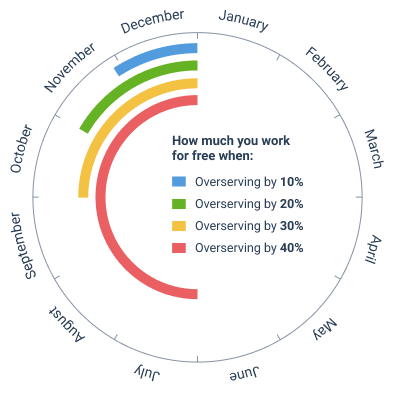Overservicing is like a wolf in sheep’s clothing. It might seem like you’re going the extra mile for your client, but in reality, it’s a silent profitability killer. It’s when an agency goes above and beyond the project scope, often driven by sky-high client expectations. This can put a dent in the agency’s profitability and lead to resource mismanagement. It’s like pouring water into a leaky bucket.
Maintaining a balanced agency-client relationship is as essential as a compass to a sailor. It’s important to align client expectations with the service’s scope, and steer clear of poor project management practices which can lead to overservicing.
So, how do you prevent overservicing? Here are some strategies:
- Clear communication between the agency and client.
- Strict adherence to project management principles.
- Efficient resource management to avoid wasting resources on excessive servicing customers.
Introduction to overservicing
Overservicing—sounds like a win, right? Well, not exactly. When a business, especially an agency, goes overboard trying to keep clients smiling, it can actually hurt more than help. Imagine an agency bending over backwards, surpassing the project's scope just to meet some sky-high client demands. What happens? Resources stretched thin, profitability takes a hit, and before you know it, you're serving one at the cost of many.
Definition of overservicing
Simply put, overservicing is when you're dishing out more customer service than necessary. It’s like filling a cup that’s already full—spillover is inevitable. This often stems from trying to dazzle clients with extra perks, excessive attention, or too many resources, all fired by the rocket fuel of unrealistic client expectations. The end result? A strained agency-client relationship and a potential dive in service quality.

The impact of overservicing on agencies
Let's face it, overshooting the moon with client services might score immediate brownie points, but it’s a precarious path. Agencies find themselves grappling with not just diminished profits but also with a phenomenon called scope creep—where the initial boundaries of the project keep expanding like dough. And here's the kicker: the more resources you throw at one project, the less you have for others, muddling overall service quality.
The root causes of overservicing
Why do agencies overservice? It boils down to a couple of crunch issues—unrealistic client expectations and a tangled web of project management. Clients might expect the moon, pushing agencies to over-deliver. Add to that a dollop of poor project management, and you have the perfect recipe for overservicing.
Client expectations and demands
Keeping client expectations in check is crucial. It's about striking a balance—aligning what clients expect with what your agency can realistically deliver without bending over backwards. Effective client management means understanding and managing these expectations right from the get-go.
Internal management issues
At the heart of the matter are internal management woes. Mismanaged projects can lead agencies to over-commit, straining both resources and client relationships. The trick? Sharpening project management skills and keeping an eagle eye on resource allocation.
Competitive pressure in the agency market
The agency world is fierce, with competitive pressure cooking on high. Agencies often feel the heat to outperform competitors, which can lead them to promise the stars. This not only increases the risk of overservicing but also can destabilize the agency’s position in the market.
Recognizing the signs of overservicing
Realizing you're over servicing is half the battle. Look out for signs like projects consistently ballooning beyond their original scope or resources depleting faster than a sinking ship. Staying vigilant can help steer clear of these pitfalls.
Increased workload without additional revenue
Here's the clincher: working more but earning the same. It's a common scenario where agencies find themselves in a vortex of increasing workload without seeing a penny more in revenue. The focus should always be on balancing quality service with sustainable profitability.
Client dependency and satisfaction levels
Lastly, while it's great to have clients rely on you, too much dependency can backfire, especially if it leads to heightened expectations. Ensuring client satisfaction without compromising your agency’s integrity or resources is the balancing act every agency needs to master.
Quantifying the cost of overservicing
Over Servicing customers, often a result of sky-high client expectations, can take a serious toll on an agency’s profitability and quality of service. It’s like trying to fill a bottomless pit. Poor project management, coupled with scope creep, can lead to excessive resource management, ultimately putting a strain on agency-client relationships.

Key areas where overservicing hits the wallet include:
- Resources spent on overdelivering
- The opportunity cost of other projects
- Increased project management demands
Understanding and managing client expectations are as vital as a compass to a sailor, helping to minimize these costs and maintain a shipshape business operation.
Financial implications
The agency’s profitability can be hit hard by poor project management and unrealistic client expectations. These factors often result in scope creep, putting undue stress on resources and potentially affecting the quality of service provided.
Furthermore, such scenarios strain the agency-client relationship, making it as essential as a lighthouse for proficient client management. Over-delivering on a project scope without proper resource management can negatively impact the servicing of other customers and affect overall customer service and reputation.
Operational and productivity costs
Managing agency-client relationships can be as complex as a Rubik’s cube, especially when dealing with unrealistic client expectations and ensuring the quality of service. Poor project management can also contribute to scope creep, putting additional strain on resources and negatively affecting the agency’s profitability.
Additionally, fulfilling the project scope while handling servicing of customers can lead to operational and productivity costs being elevated. This not only affects resource management and the ability to over-deliver but can also compromise customer service.
Successful client management therefore involves setting clear expectations, managing resources effectively and maintaining a consistent level of service to avoid undue costs and maintain productivity.
Strategies to prevent overservicing
To avoid overservicing and maintain the agency’s profitability, implementing effective project management is key, with a strong focus on project scope and resource management.
Clearly defining the scope from the project’s outset, setting realistic client expectations, and frequently reviewing it can prevent scope creep. This helps check the quality of service from exceeding what’s necessary or agreed, ensuring no over-deliver.
Furthermore, servicing customers should not compromise the agency-client relationship.
Regular communication, ensuring clients understand the resources needed for desired outcomes, and promptly addressing unrealistic client expectations can prevent overservicing. Adopting these strategies will foster a healthier client management approach.
Setting clear service boundaries
Setting clear service boundaries is integral to promoting a healthy agency-client relationship. It serves as a guardrail against unrealistic client expectations, scope creep, and poor project management - factors that can threaten an agency’s profitability. It’s through clear expectations that over-delivering becomes manageable.
Effective boundary setting enhances project management, resource management, and client management, which are key factors to servicing customers effectively. Thus, quality of service improves, supporting the agency’s capability to maintain a more satisfying customer service experience.
Effective communication with clients
Effective communication is fundamental for customer service and servicing customers, as it underpins a positive agency-client relationship. It is critical in managing client expectations, particularly when dealing with unrealistic client expectations. Open and clear communication helps to clarify project scope, assisting in process management, and preventing scope creep.
Moreover, successful communication in project management can significantly enhance an agency’s profitability by improving resource management. Over-delivering in terms of the quality of service provided can also be achieved through strong client management. Ultimately, effective use of resources and efficient project management are dependent on robust communication channels with clients.
Role of technology in managing overservicing

Technology kicks things into high gear when it comes to balancing the agency-client seesaw. It's all about keeping project management slick, reining in scope creep, and making sure resource management is on point. In the grand scheme, this tech touch keeps the cash registers ringing while ensuring clients get just what they need, no more, no less.
Digital doodads and whatnot are game-changers in setting client expectations. They help agencies deliver A-one service without stretching too thin or getting tangled in pie-in-the-sky client wishes. Tech tools are real lifesavers, preventing over-delivery and keeping project scopes and client management well within the realm of reality.
Using project management tools: Asana, Trello
Tools like Asana and Trello turn project chaos into order—they’re real MVPs in delivering top-notch client service and keeping things smooth between agencies and clients. These tools are champs at outlining clear project boundaries, blocking scope creep at the pass, and ensuring quality service. They’re wizards at resource management, which spells better profits for the agency.
Gone are the days of project management mayhem with these handy helpers. They come packed with features to ace customer service, manage resources, and keep client hopes in check. Plus, they play a big part in uplifting service quality.
Whether it's juggling client management or avoiding over-delivery, Asana and Trello are essential in all project management plays. Wrapping up, their savvy use can crank up customer satisfaction and fatten up profitability.
Time tracking software: Harvest, Time doctor
Keeping resources aligned and client service efficient is crucial for keeping the agency in the black. Time tracking software like Harvest and Time Doctor are ace supporters in refining project management and dodging the pitfalls of scope creep spurred by sky-high client expectations.
By keeping a close watch on project scopes, these tools let agencies lavish attention on customer service without messing up resource management. This boosts service quality, strengthens the agency-client bond, and sharpens client expectation management.
Training your team to avoid overservicing
Training your crew to stick to project boundaries and ace agency-client relations is key to sidestepping overservicing. Tackle hurdles like lofty client expectations and project missteps that could bleed the agency dry. It’s also vital to set crystal-clear client expectations to strike a balance between stellar service and overdoing it.
Training highlights include:
- Sketching out necessary resources based on project scope to dodge scope creep.
- Valuing service quality over going overboard with client pampering.
- Enhancing project and client management practices to cut down on crossed wires.
Creating a culture of efficiency
Crafting a culture of efficiency is all about tight client and resource management. Core practices include setting straightforward client expectations to stave off scope creep and ensuring service quality through robust project management.
At the same time, tackling unrealistic client expectations helps in serving customers without jeopardizing agency profits or overshooting the project scope. A strong focus on customer service also boosts the agency-client relationship. Smart resource use and allocation can curb issues linked to project mismanagement.
Training on client management skills
Mastering client management skills is crucial for enhancing the agency-client relationship and customer service. These skills help in consistently serving customers while managing unrealistic client expectations, thus boosting the agency's bottom line. Strategies include clearly defining the project scope to prevent scope creep and efficiently managing resources.
Solid client management also means getting project management right to avoid botched projects. This ensures that, regardless of the resources available, service quality stays top-notch. It's crucial to avoid over-delivering and taxing the company’s resources. Setting firm and realistic client expectations right from the start is key to managing clients effectively.
Conclusion: The balance between service and profitability
Managing the agency-client relationship expertly is key, focusing on effectively serving customers while keeping client expectations real. Striking a balance between project management, resource management, and the agency’s profitability can be a tightrope walk. Yet, maintaining this balance is essential to avoid scope creep and uphold service quality, ensuring the agency doesn’t over-deliver at the cost of resources.
Agencies must remember that stellar customer service and robust client management practices are crucial for their reputation and profitability. Though it’s a balancing act, this equilibrium is achievable with meticulous planning and clear communication.
Shoddy project management could drain resources, diminish service quality, and ultimately hit the agency’s profitability. Thus, prioritizing effective project and client management should always be on the agenda.







